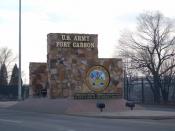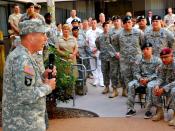Air Force Academy Hospital Management Working for over four years in health service management in the hospital at the Air Force Academy, Colorado Springs, Colorado, I have distinct experience and knowledge of the specific management functions that is used as for the hospital's mission. I've worked directly with the management there in hospital administration and as the Commander's assistant. I've also recently conducted interviews with staff and the current commanders there. The management structure, style and the internal/external environment all are important skills and factors that affect the hospital and its personnel.
The structure of the Air Force Academy is a basic militarily designed management level. There is one commander who is in charge of the entire hospital, making final personnel decisions, and command hospital functions. He is Colonel Jay Sprenger, and usually they remain in the position of Hospital Commander for approximately three to six years. Colonel Sprenger took command of the Air Force Academy hospital in June of 1999, and should only have another year left as commander there.
Colonel Sprenger is a surgeon and has been for the past 22 years. Being a doctor is not required for the command position, as in the past it has been filled by nurses, medical service corps officers, and others.
Next in the chain of command is Colonel Sprenger's Deputy Commander, Colonel Davis, a nurse. She is also in charge of the nurse corps at the hospital, and oversees all functions within their duties and training requirements. Colonel Davis and Colonel Sprenger work together on many of the hospital issues, personnel requirements, and ensuring the hospital mission is being met. Colonel Davis is also the acting commander whenever Colonel Sprenger is out or not available. There are also four squadron commanders who work for Colonel Sprenger in the hospital chain of command.
Colonel Googins is the commander for the Support Squadron. He is a medical service corps officer and has been working in this position for about three years now. The Support Squadron consists of all administration duties to include: patient registration, medical records, and quality assurance. The Support Squadron also consists of ancillary services such as: pharmacy, laboratory services, and radiology. Colonel Googins has approximately 150 personnel in his squadron, which includes about 65 civilians. This squadron is very customer oriented and tasked. Personnel working in these services are usually the first and primary contact to patients. When patients make appointments, get their records, or check out of the hospital, their point of contact will always be someone from the Support Squadron. Colonel Googins takes special consideration to patient satisfaction. He is always open to patient comments or concerns, answering any complaints or compliments his squadron, and the hospital may receive.
To ensure the customer satisfaction at the hospital, Colonel Googins holds quarterly meetings for his key personnel, which includes the managers of each department, or Officer in Charge in the military term. These meetings consist of the results of the voluntary customer satisfaction surveys, which are available throughout the hospital. All complaints or compliments that were received in the quarter are discussed, with possible outcomes and solutions to concerns. Most of the complaints get immediate attention with the NCOIC (Non-Commissioned Officer In Charge) contacting the patient, gathering all data possible, and then speaking with the clinic or personnel the complaint is about. He takes this information and formulates the most logical and reasonable conclusion that will satisfy the patient and do the least to discredit the hospital. Most of these complaints are filed because of patients being unable to make timely appointments within the hospital. Depending upon the nature of the appointment and what services the hospital has available; the NCOIC usually can resolve this by working with the needed physician or clinic and getting the patient in sooner. With two major military hospitals within the area, the Air Force Academy, and Fort Carson, and the limited budget the military provides hospitals, the Air Force Academy is driven to keep their current patients so the hospital can continue running at the highest level possible, offering the most services available.
The external environmental factors are important for Colonel Googins and his managers to understand and keep track of. Although there is little competition with Fort Carson, civilian hospitals, and the military as a whole, it is essential for the Air Force Academy to meet and possibly exceed patient expectations to keep the hospital as their choice. As military funds become less available to the hospital, some services are eventually looked at to be outsourced. These are services that the hospital will contract with civilian hospitals if the need is more cost-effective. Most of these services are those which: military personnel are less available to fill the required positions, and the number of patients requiring the service is few. Recently the Air Force Academy had outsourced its inpatient OB/GYN care. This was due to the facility needing extra room to expand its Ambulatory Surgical Unit (ASU). The hospital had the required personnel needed to run its OB/GYN unit, but the amount of room it needed to provide inpatient care for this service was extensive compared to the number of patients that actually used the facility. Patients requiring ASU services were growing, and the limited space the hospital provided for this service became too small to accommodate the patients. This led to longer waits for appointments, exhausted employees, and a lesser quality of service than what could be provided.
This in-turn led to the decision to move the inpatient OB/GYN services to a nearby civilian hospital to leave that space at the Air Force Academy to serve the growing ASU. This was looked at as the most cost-effective way to meet the needs of the patients and the hospital. This transition took about seven months, and at first patients were not happy with the change for many different reasons. Some didn't like having to go to an unfamiliar hospital for their inpatient OB/GYN care, even though they still saw the same military providers as before. The initial dislike for the change eventually altered to an appreciation for the new services. ASU patients were able to be seen much sooner than before, and OB/GYN patients began to like the newer civilian facility in which they received their inpatient care. The decision to change these services was very closely thought out, statistical data was reviewed, and patient care was key in the process. Without looking at all ends of possibilities for this move, it could have been disastrous.
Making the decision to move the OB/GYN inpatient care had to be reviewed stringently. All of the clinics within the hospital were reviewed to determine which one could be eliminated or outsourced without causing the most interruption of services and patient satisfaction. The necessity of a larger ASU was also closely examined. It had to be determined that a larger ASU was needed, or if it would be more feasible to move the overload of patients to a civilian hospital or Fort Carson. Colonel Googins was in charge of this decision and actively had all of his managers involved. He used the internal factors of the hospital to decide on the change it needed. He had his managers conduct data surveys to compare the patient load of each clinic with the personnel required to run the clinic and the necessary space in the hospital needed. This was done over a period of 6 months. The direct use of the managers within the hospital was essential in determining the most appropriate transition for the ASU.
Colonel Davenport is the Operations Squadron Commander. He is in charge of about 12 clinics and 210 personnel. The Operations Squadron consists of direct patient care treatment to include: family practice, pediatrics, emergency services, and general surgery. This squadron consists of most of the doctors, medical technicians, and nurses in the hospital. The Operations Squadron also has direct patient care on a daily basis. They are patient providers and come in contact with patients on a daily basis. The medical care provided to patients is very important to the hospital. Colonel Davenport is very involved with continuing education and medical training. With the growing medical opportunities and information available, it is important that the medical treatment team gets updated with these changes. Colonel Davenport spends much of his time organizing and sending his providers to trainings to update their skills and ensure the best care to the patients of the hospital.
Colonel Davenport also worked directly with many patient complaints. Although this was a Support Squadron function, many complaints did come in about patient care, which affected Colonel Davenport's squadron. Colonel Googins and Colonel Davenport would work together on patient complaints that were reflected on the Operations Squadron, and Colonel Sprenger would be informed and involved when necessary for all complaints at the hospital. The chain of information between the commanders is important for the hospital's function. They have daily meetings to update each other on concerns and updates for the hospital and for their squadrons. This keeps everyone informed on changes and offers the opportunity for other commanders to provide input if needed. The commanders also have weekly meetings alone with Colonel Sprenger to discuss issues within their squadron and personnel. This keeps Colonel Sprenger aware of problems that he might be addressed with later in making disciplinary decisions or personnel changes if necessary.
The next commander is Colonel Wright. Colonel Wright is the Dental Squadron Commander and has approximately 65 personnel working for him. He has been a dentist for over 24 years and is in charge of all dental care and administration. Due to the smaller size of the dental squadron, all administration duties are assigned to Colonel Wright rather than Colonel Googins. Colonel Wright works directly with his managers in customer satisfaction and personnel issues as well as direct care. His main focus is his employees. The squadron he commands is much smaller than any other, and this gives him more of an opportunity to know his employees better and work with them on a more personal basis.
Colonel Wright knows all of his employees by name, their goals, and their family. He focuses on morale within his squadron and takes special time to recognize his employees. Colonel Wright holds many competitive boards for both his civilian and military personnel. Every quarter he holds an employee/soldier of the quarter board in which OIC's and NCOIC's nominate their employees for. The employees, if they choose, then compete at these boards by answering questions to a panel of judges. The judges then choose the most professional employee for the honored award. This continues to employee/soldier of the year. Many people are motivated and desire to be chosen for these boards. It is a friendly competition and a nice recognition for staff.
Colonel Wright also meets directly with each employee after evaluations. Evaluations are required by the military to be completed every 180 days, sometimes sooner depending on circumstances, but Colonel Wright requires informal evaluations to be done every three months so employees have an ongoing knowledge of their performance. After their formal evaluation, which is done in six months, Colonel Wright takes the time to meet with the employee, discuss their performance and highlight their positive aspects. He also encourages them to improve struggling areas and to get involved with community events. This is significant to the employees as they are aware that Colonel Wright knows them and knows of their performance. Without this personal use of management, if Colonel Wright decided to meet with them every six months, he wouldn't have direct knowledge of the employees' performance and his criticism would be skewed. Staff would not take what he had to say for face value, probably claiming that he didn't know what he was talking about. Colonel Wright's personal management can be done on this level as he has a smaller amount of employees to know, where as the larger squadrons probably couldn't effectively do this.
The last commander under Colonel Sprenger's team is Colonel Mary Evans who is the commander of the Aerospace Medicine Squadron. This squadron consists of about 95 personnel, all of whom are in the military. The Aerospace Medicine Squadron is a separate medical clinic, which sees all military members that are on flight status, this squadron also processes all physicals for individuals seeking flight status.
The Air Force Academy is a somewhat larger Aerospace Medicine facility due to the amount of cadets, which train for flight status. There are also several smaller bases around the Air Force Academy, which has members on flight status to include: Peterson Air Force Base, Cheyenne Air Station, and NORAD. The geological make-up of the Aerospace Medicine Squadron makes it a unique clinic.
The main clinic is located on the Air Force Academy, and consists of five physicians and over 40 support staff, including medical technicians and laboratory technicians. There are also satellite clinics located at the various Air Force Bases. The satellite clinics usually have one physician or one physician assistant working at a time. Due to the geographic location of the facilities, it isn't uncommon for someone to be working miles apart from their supervisor, and have rare contact or communication with each other. This has hindered many management decisions in the past.
With having five different facilities within the Aerospace Medicine Squadron, personnel are often moved on a weekly basis from one clinic to another while their supervisors and managers could possibly work in a separate location. This is not the most effective type of management for the organization. As Longest states (21) "An important ingredient in managerial success has always been the cluster of knowledge and related skills about employee interactions and relations by which managers direct or lead others in the pursuit of organizational objectives." This factor is basically lost in the disassociated management of the Aerospace Medicine Squadron. Managers are not available to their staff and direct employees can't be led or learn from their supervisors when they aren't present in their workplace. Longest also states (58) "It is important for managers to be available to their employees for skills training, direction, supervision, and performance feedback. This creates a lack of the necessary knowledge managers need from their employees and the relationship required to effectively communicate with each other." The need for continuous feedback is essential for employees to grow within their job performance and knowledge of their duties. Shortell states (124) "Leadership is a performing art; becoming proficient requires continual and intensive coaching from an experience practitioner who is invested in development. There is a growing body of evidence that suggests that establishing an effective mentoring relationship is one of the most important things separating successful from unsuccessful leaders and managers." This shows the significant need for a leader who is accessible and active as a mentor to their staff. Quick telephone conversations and hearsay about work performance is not a good tool to evaluate performance. There is a constant need for the personal relationship and communication between managers and their employees.
The use of many facilities within the Aerospace Medicine Squadron, and its lack of interpersonal management is an internal factor that the hospital faces. There are also many other internal issues that affect the management of the Air Force Academy hospital and its squadrons. One big internal factor is the lack of continuity of personnel. The military constantly moves people from one location to another, and from one position within the hospital to another. This causes employees to have a lack of continuity within their job, and a lack of effective employee/management relationships. Quite often managers only supervise their employees for a few months before they move or switch positions, or the employee moves. This will create an employee performance report that stays with them for their career and affects their promotion ability. It is rare that the supervisor who has worked with the employee for a period of only a few months to have complete insight to their job performance and skill knowledge.
The lack of continuity within the hospital also affects patient care. Retired patients and other patients who build a rapport with a certain physician or medical provider, quite often have them leave. The patients therefore have to be seen by the next provider who is available. This leaves the patient at times feeling uncomfortable with the change and dissatisfied with their service. Without being able to establish a consistent and satisfying relationship with providers can hinder health care organizations and leave the patient seeking other service providers.
Another external factor that affects the Air Force Academy Hospital management is the booming economy in Colorado Springs. When the hospital was first established, about 35 years ago, the economy in Colorado Springs was bare. The city land was spread out, with little population to it. The Air Force Academy Hospital had to offer many services to its members as there weren't many other local resources to share the patient needs. With the recent technology boom in the area and the population growth that Colorado Springs has seen in the past 15 years, civilian patient care services began to flourish, providing the military and its members other options in patient care. This caused the hospital's care system to both decrease, and increase.
The hospital had to increase in the number of patient care providers as the amount of military members within the area expanded. To become more cost effective the hospital began to refer many of its specialty services to the civilian providers, as there wasn't a large enough patient load within the Air Force Academy to justify continued service there. The hospital also had to increase the number of Family Care Practitioners as the military population grew and this service was most in demand. This diversification helped the hospital's patient service and was cost effective to the military.
With six commanders representing the hospital, there was also a flow within each squadron consisting of anywhere from 8 lead managers to 26. The smallest squadron, the dental clinic, has 8 managers who work directly for Colonel Wright. The largest squadron, Operations, has 26 lead managers who work directly for Colonel Davenport. The other squadrons also have a combined total of 32 lead managers. With the military being the diverse place it is, the management style between these people varies greatly.
Managers within the Air Force Academy hospital, like most military hospitals, face a great deal of diversity each day. With a large mixed ethnic population, age difference, and gender differences, managers are faced with different experiences and challenges on a daily basis. As women are viewed as leaders, Shortell states (126) "Overall, there seems to be a stereotypical view of women possessing fewer of the qualities considered essential for exercising the leadership role of the manager in health service organizations." With 34% of the lead managers within the Air Force Academy Hospital women, it is important for them, their subordinates and supervisors to view them in a leadership role and respect their decisions. For the continued and increased diversity within the hospital, constant sensitivity and equal opportunity training is conducted.
Military service members must try to get passed many stereotypes and biases they may have once thought true. Training is conducted annually for Air Force Academy hospital personnel. As Shortell states (351) "With an increasingly diverse workforce containing greater numbers of women, minorities, and immigrant workers involved in management or delivery of health services, the need for removal of potential stereotypes and biases is significant." The hospital is very adamant about this, and even though the lead managers and commanders are predominately white males, the training on harassment, equal opportunity, and sensitivity issues are strictly enforced and abided by.
Speaking with one of the lead managers in the Support Squadron, Major Russell Schnell, he spoke about his experiences with the diversity and how it is related in his management style with me. Major Schnell has been in the Air Force for 9 years and has been the Officer in Charge of Medical Readiness for approximately one year now. He mentioned that he grew up in a small town in Connecticut, not having met a person of African American decent until he joined the military. His fears and biases about this were difficult to overcome, and he admits that in his earlier years as a Lieutenant, he was very prejudiced against people of different ethnicities.
Major Schnell has worked on his biases throughout the years and felt the military did a good job teaching and training him on how to become an effective leader throughout the diverse spectrum of employees he supervises. The hospital and the military in general do apply theories taught in the course by continuously training their staff on issues in diversity.
With the many factors affecting management in the Air Force Academy hospital, it generally does follow many of the issues this course has discussed. It is an established hospital and has had changes to it throughout the 35 years it has been around. Many things affect its leaders, commanders, and management team, but with continuous training, communication and performance evaluations, the hospital seems to be in compliance with my training from this course.
The six different commanders who are essential in the hospital's function all have different leadership styles and traits. Two of these commanders are female and do seem to possess a sensitivity to their employees, one with a more laissez-faire style of leadership. Colonel Evans has this trait and is much more laid back, letting her staff make most of the decisions needed, providing little input with them. Colonel Wright, as described before, uses supportive leadership. He is friendly, approachable, and exhibits consideration for the status, well-being, and needs of followers.
Colonel Googins is a very consultative leader. He is, at times, democratic in his decision making process by asking staff for their input, but usually he makes informed and decisive decisions on his own when needed. His employees usually don't question his decisions, but he welcomes discussion on them if there is confusion or clarification is needed. His employees accept and view Colonel Googins as a powerful commander who "gets things done." Colonel Googins is not without a sensitive, staff awareness, side to him. He knows his personnel, makes an effort to get out and talk to all of them and is open to suggestions or questions from them all, despite military rank. His squadron has won the "Squadron of the Year" award for the past two years, and continues to mold his military soldiers into award winners, as his squadron has won the most personnel awards in the past four years. Many employees respect Colonel Googins and his decisions, feeling he is very "knowledgeable and experienced" according to Airman John Vett.
Colonel Davenport's leadership style is noticeably autocratic. He makes decisions and expects follow through without questions or hesitation. He is very military like, always wearing a clean crisp uniform to work each day and expects his soldiers to respect his rank and position of authority. Colonel Davenport's squadron noticeably is lacking a sense of morale, as many people working in the Operations Squadron feel tired, overworked, stressed, and "walking on pins and needles" as stated by Staff Sergeant Ray Taylor. Colonel Davenport makes all of the decisions within his squadron, without really getting input or advice from even his lead managers. As Captain Dedire Small stated "It puts a lot of pressure off everyone else, he makes an informed, command decision, and sticks by it. If something goes wrong, he has no problem correcting the action and going out on a limb on his own for the decision. He is admirable in that respect, though difficult to talk with at times, it is still nice to be able to present problems and see what the command solution would be." From the 500 plus personnel at the Air Force Academy Hospital, there will be difference in opinions, feelings, and thoughts about the leadership encompassed in each commander. There are distinct differences between them all, but the system as a whole seems to function well and follows distinct descriptions as noted in this course. Individual commanders are male, female, white, and African American, but no distinct lines can be drawn or stereotypes made from them. The hospital is not without flaw, there are continuous patient complaints and concerns being addressed, budget problems, and staffing disputes, but this will be obvious in any facility. The way the management team handles these concerns is what is noticeably important. They each have different techniques and skills, but when coming together as a team their ideas flow and work with one another.
The constant training, performance feedback, and quality assessment has played an essential role in maintaining the Air Force Academy's hospital. The managers have different styles, but are all important in hospital relations. The change and continuous turn-over makes continuity impossible at the hospital, which is at times a hindrance in effective management. Overall, the hospital does use key conditions and implements important tools as described by this course. The military makes any Health Service Organization difficult to follow and process due to the differences it faces and the constant change it undergoes. With the external competition, internal budget concerns and constant personnel changes, the hospital is still a large important facility to the Air Force Academy, and to the military.




